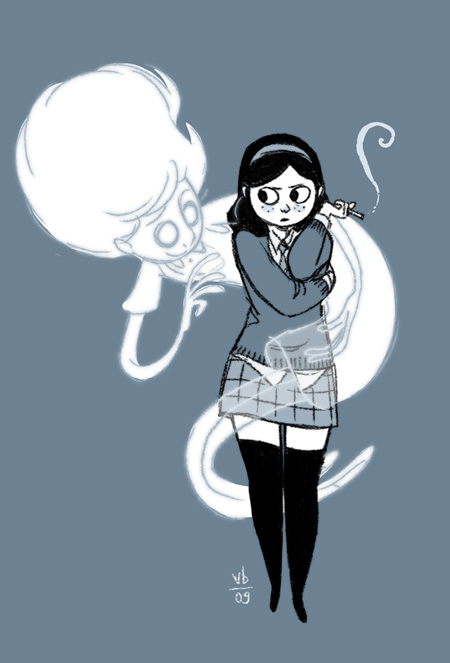Anya’s Ghost.
Vera Brosgol – author and illustrator. (2011). Publisher: First
Second(:01): New York. Hardcover. ISBN: 978-1596437135.
Author website: http://verabee.com/index.html
Media: Watercolor, pen and ink.
Genre: Graphic novel, multicultural, horror
Annotation
A lonely teenage girl struggling with everyday problems encounters
and befriends a ghost. Only there is a problem, what happens if this ghost is
less Casper and more poltergeist?
Plot Summary
Anya, an angst ridden teenage girl who is an imigrant from Russia
going to a Catholic school in suburban Massachusetts, wants to fit into
mainstream teenage culture and wants to be popular. She tries to assimilate and
blend in with her peers. For example, she went to speech therapy to lose her
accent, dresses like the other girls, she eats American foods, and she rejects
the Russian food (Cblphnkh) that her mother cooks because it is Russian and
weight self-consciousness.
Anya is leaving high school one day when she trips and falls down a
well in a park. Terrified that she is
doomed to perish in the well, Anya discovers that she is not alone. There is a
ghost girl and skeleton from 1918 with her. When she is finally rescued, she
discovers that the ghost had an ulterior motive. The ghost, Emily, has followed
her home. At first, the ghost is helpful. The ghost assists with course work,
gives her intel about a boy she has a crush on, boosts her confidence, provides
style advice, and so on. The ghost seems like a supportive friend that
teenagers often want.
But, as the story progresses, Anya starts to realize that the
ghost’s story isn’t quite right. As the ghost becomes more co-dependent,
demanding, erratic, and scheming Anya begins to suspect that the ghost is
leaving out information and decides to investigate the said story. She
discovers that there is more to the ghost and the story and that her family
might be in danger.
My thoughts
This is a good young adult graphic novel for teens and is popular
for many reasons. Social anxiety, body image, friendship, health, peer
pressure, family difficulties, and assimilation are issues that are effectively
addressed in this graphic novel.
Anya, as a character, is so relatable for many teenage girls. She is
a combination of social outcast rebellion and intelligent but insecure
wallflower. The character progresses through the story and in the end she
realizes that the popular kids have issues below the surface. Anya ultimately
becomes more secure with her own being and confident that she doesn’t have to
fit in with the popular kids.
The illustrations are monochromatic done in black and white with a
touch of purple toned grey. The lines are thick and smoothly in a typical
graphic style. Anya is drawn as a curvy girl with dark hair and freckles.
A couple of red flags: One personal concern that I have is that the
character does smoke cigarettes (and cut classes) through the first part of the
book. This characterization of the rebel smoker is cliché and perhaps causes
teenage girls to smoke. The characterization adds to the problem even though
the character confronts the habit in the final pages of the book. In addition,
there is underage drinking at the party that changes her views about
popularity. Overall, the spooky supernatural themes are mild and there is no
overt violence.
Curricular connections
Popular for teenage girls.
Literary Devices:
Use of onomatopoeia:
beep! Beeeep!, Clap!, pant pant, gasp, tweet tweet, briiiing, whip, duck,
rrrring, sizzle, krak, thump, tug, and THUD.
Use of Simile:
“You may look normal like everyone else, but you're not. Not on the inside.”
Reading level/
Interest Age
Younger high school.
Reviews and Awards
Cybils awards
2011 in the Graphic Novel category
Booklist
starred review
Kirkus starred
review
School Library
Journal starred review
“Anya’s
Ghost is a masterpiece, of YA literature and of comics.”—Neil Gaiman
"Remarkable.
. . . with an attitude and aptitude reminiscent of Marjane Satrapi (Persepolis)
who likewise conveyed the particulars of an immigrant adolescence, Brosgol has
created a smart, funny and compassionate portrait of someone who, for all her
sulking and sneering, is the kind of daughter many parents would like to have.
And the kind of girl many of us maybe once were.” -- The New York Times
Cinderella Skeleton by
Robert Souci and David Catrow







